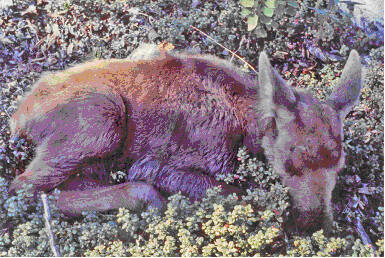By Stephen F. Stringham
If the goal of moose management on the Kenai Peninsula is to maximize the number that can be harvested year after year for decades, then the Board of Game cannot do it by trying to maximize size of the moose population.
The moose carrying capacity of the Kenai Peninsula is defined as the maximum number of moose that can survive here, as evidenced by past numbers here or in comparable habitats elsewhere. More generally, carrying capacity is the maximum numbers of animals per 1,000 square miles — that is, the maximum population density — that a habitat can support. Historically, when the Board of Game has proposed keeping moose populations near carrying capacity, they have equated that with maximizing density.
However, maximum isn’t necessarily optimum, as cattle ranchers learned long ago.
Anyone familiar with cattle ranching knows about overgrazing: Running so many cow-calf pairs and steers that they eat their forage faster than it can regrow, damaging the plants so badly that they don’t produce as well in following years. The herd may be large, but the cattle are skinny. Unless size of the herd is reduced, the range will tend to keep deteriorating. So will the cattle themselves, increasing their vulnerability to parasites, disease, predators and foul weather. Some bad winters have killed enormous numbers of poorly nourished cattle.
Savvy ranchers eventually learned that cattle herds are most productive and most profitable when kept in balance with their food supply — not at maximum density, but at optimal density. No matter what regulations say about trying to keep moose populations at carrying capacity, the Board of Game needs to avoid interpreting that as maximum density and equate it with optimal density — which in wild hoofstock populations may be as low as 50-80% of maximum. Moose that pack on fat during summer have much better survivorship over winter, especially when deep snow minimizes the nutritional profitability of them traveling from one forage site to another.
The amount of moose food grown can be greatest in the first decades after wildfire, then decline as a forest regrows, as has happened here on the peninsula, reducing carrying capacity. Carrying capacity is determined by the amount grown, minus the amounts eaten by insects, rodents and other small herbivores. Although those critters are tiny compared to livestock, they can be far more numerous, and their metabolic rate is much higher. It takes many fold more food to support a ton of rabbits than a ton of hoofstock. In one ranching habitat, rabbits consumed 34% of forage, leaving only 66% for livestock, a one-third reduction in livestock carrying capacity. The abnormally high rabbit abundance was an unintended consequence of excessive predator control.
Although the impacts of rodents and rabbits/hares has been most dramatically recognized on ranches and farms outside Alaska, our own wildland habitats are not immune. Snowshoe hares not only compete with moose for some foods such as willow shrubs, but hares kill a lot of stems by girdling them; and their saliva allegedly causes plants to produce more toxins that impair digestion on any critter that eats them. The 1,2,3 punch delivered by hares can hit moose hard. According to rough calculations I’ve made, during peaks in snowshoe hare abundance, hares could seriously reduce moose carrying capacity of the peninsula, unless we have enough predators to keep hare numbers in check.
In order to maximize moose harvests, we need to avoid striving to maximize moose density or minimize predator density. Instead, we must strive for the optimal densities of both moose and predators. How does the abundance of bears affect numbers of wolves; and how does wolf abundance affect numbers of coyotes, lynx and foxes? At what ratios of various predator species to hares is density of moose optimized? What is their optimal carrying capacity? Determining optimal densities of moose, hares and predators is a challenge requiring considerable scientific expertise. Fortunately, Alaska hires first-class biologists. On the Kenai Peninsula, we are fortunate to have Jeff Selinger, who did a wolf-moose study in the Lower 48 before coming to Alaska. After serving for decades as area manager, he became regional coordinator.
Replacing him as area manager is Nick Fowler, an expert how on the abundance of wolves affects abundance of coyotes, which in turn affects abundance of foxes (and here, lynx) — knowledge essential for identifying the best ratios among predators for keeping hare and rodent numbers in check. We also have wildlife physiologist John Crouse, as well as wildlife biologists Dan Thompson and Jacob Pelham.
Where additional expertise is needed, they can turn to biologist Nate Svoboda on Kodiak Island, and to those in Anchorage. Our team of local Alaska Department of Fish and Game scientists is highly skilled as field biologists as well as thoroughly trained in book knowledge, computing and other technologies.
Let’s hope that when the Board of Game meets here in mid-March that they refrain from dictating to these biologists and take their expert advice on how best to maximize moose and caribou harvests on the Kenai Peninsula.
Stephen F. Stringham, PhD is a certified wildlife biologist and president of WildWatch Consulting.

